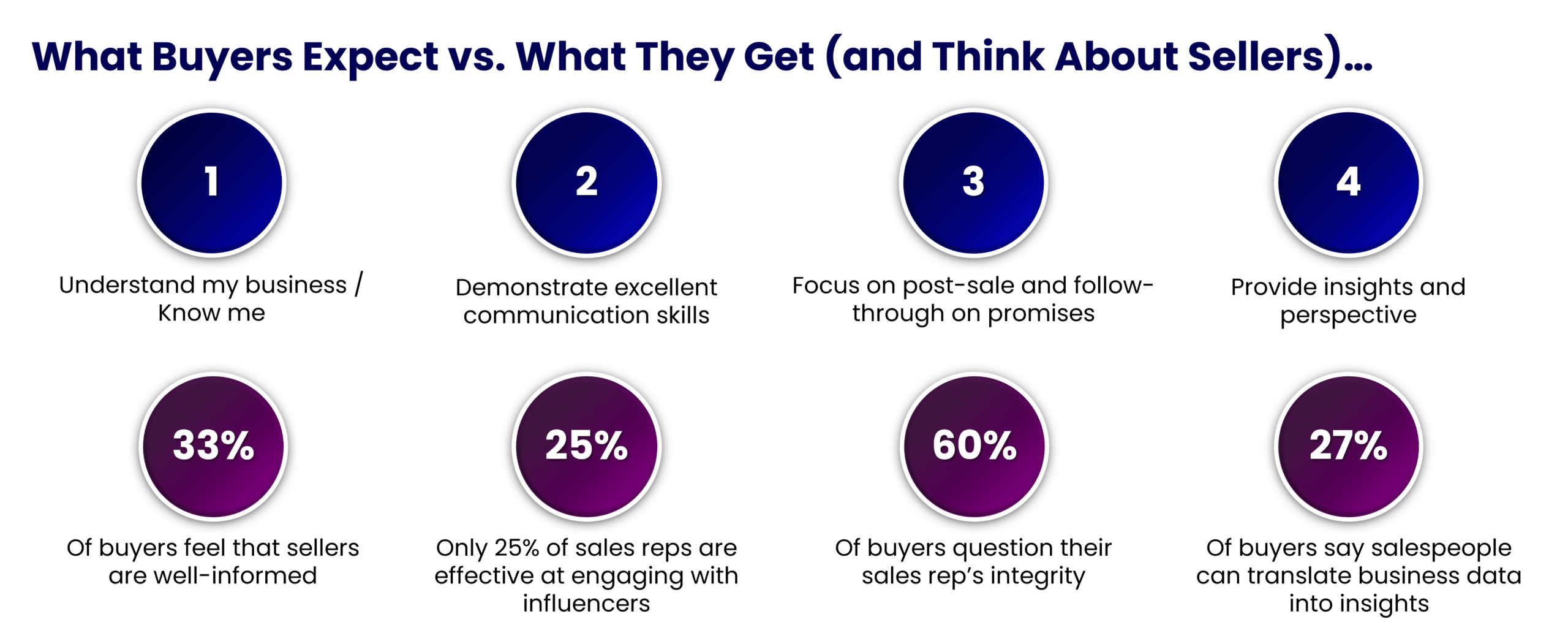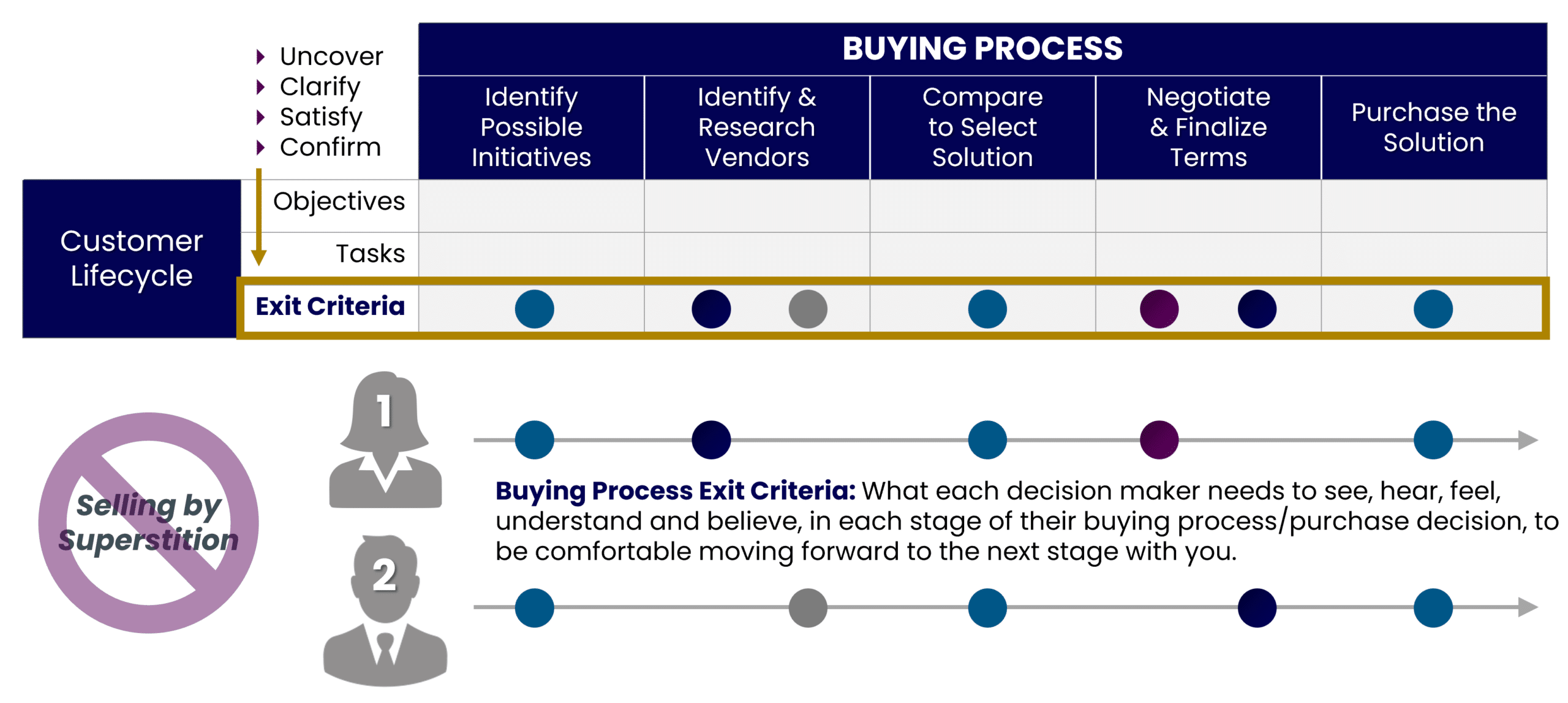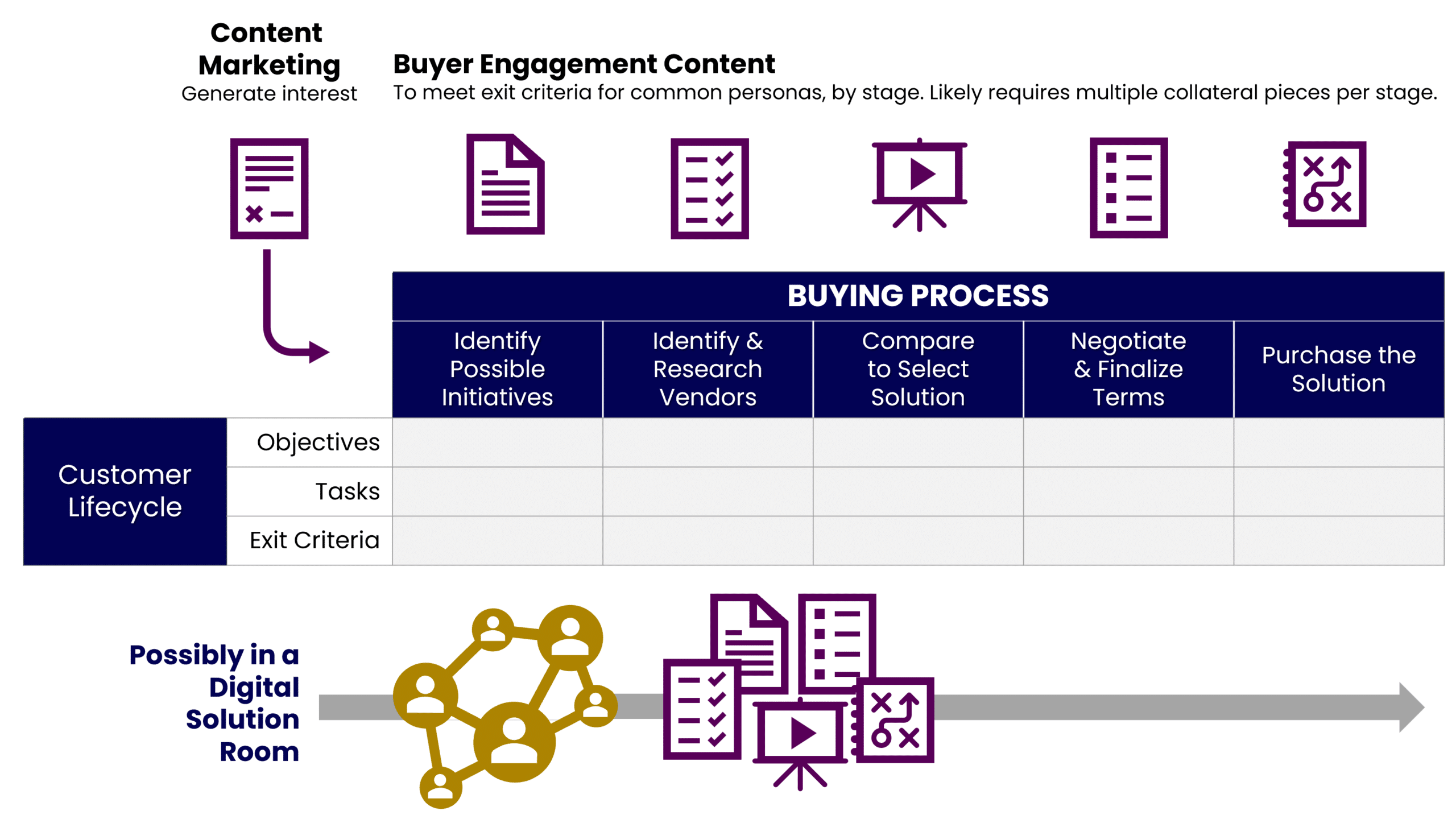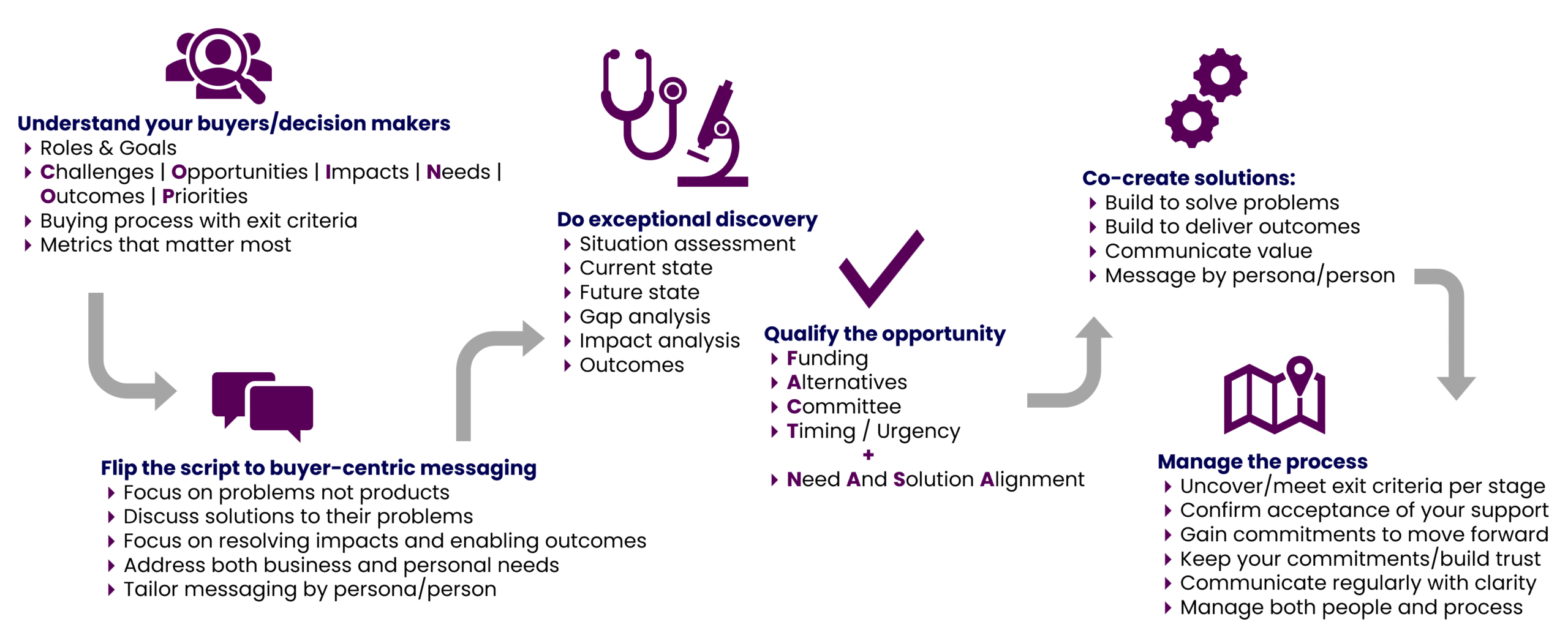In my last post, I discussed sales enablement, how it can help your company and how to get started. One of enablement’s key responsibilities is preparing and supporting your sellers to go to market as effectively and efficiently as possible. And part of this responsibility entails evolving your sales methodology to align with how modern buyers want to buy, what they expect from sellers and what they need along their journey.
B2B Buying Behavior Continues to Evolve
Gartner, Forrester, McKinsey, Korn Ferry, and others have been researching and reporting changes in B2B buying behavior for years now. Sales have been slow to adapt.
Recently, the global pandemic rapidly accelerated behavior change on both sides. We are seeing some bounceback now, but not to the pre-pandemic state. Several things are abundantly clear from the ongoing buyer research:
- Many B2B buyers are disappointed with seller behavior.
- An increasing number of buyers are involved in key purchase decisions (referred to as “the complex sale”).
- Some buyers (especially Millennials) prefer to avoid interacting with salespeople for as long as possible (or altogether).
- More buying occurs digitally or with a hybrid of digital (increasing) and in-person (declining) interactions.

Because of the maturity of our industry, the average age of employees and average time in role (compared with SaaS, High-tech, or Fintech, for example) the more radical changes in B2B buying are just beginning to surface in wholesale distribution. This is especially true as buyers from younger generations are promoted into leadership roles or procurement positions.
Things to remember:
- Context reigns. The transition speed is going to vary even by customer. The general research indicates trends. You must study YOUR buyers and customers, and others like them.
- If you move too quickly toward digital buying and reduce seller headcount, hustling competitors with more hungry hunters (market-makers versus market-servers) may steal your customers and market share.
- If you adapt too slowly, buyers who are ahead of pace will avoid you and eventually you’ll be an irrelevant Luddite.
So, what should distributor CEOs and senior sales executives do?
The Path Forward
There are entire books on the topic of sales transformation, but for this topic (adapting to modern buyer behavior) and this post, let’s focus on three key pillars:
- Adapt to the current state of your buyers’ behavior, with an eye toward the future.
- Get processes and systems in place to fully support digital-buying behavior.
- Make the shift to a sales methodology that is purposefully buyer-centric, consultative, value-focused and outcome-oriented.
There are many sales and management consultants, myself included, who sometimes poke at distributor sales forces for having existed for so long with a service orientation, rather than (what other industries consider) a true sales orientation (some refer to “market-makers” versus “market-servers”). To be clear, I’m not changing positions – I do believe we need to become market-makers. My counterintuitive point is this:
The long-term service orientation in wholesale distribution can be a good springboard for becoming buyer-centric, consultative sellers – if we transition purposefully.
Many other verticals are hampered by overzealous sellers who still think it’s 1970. They “never take no for an answer,” have a penchant for firing off retorts to “overcome objections” (so combative), believe in “ABC selling” (always be closing) and live in a constant state of product-pitching and feature-dumping. It’s no wonder buyers try to avoid them.
In distribution, while we do need to evolve, we’re generally starting from a more service-oriented, problem-solving, relationship-based perspective – and that’s encouraging. It’s not sufficient, but it’s a great launch pad.
With that in mind, let’s explore these three key pillars.
Adapt to Your Buyers and Customers

- Many companies think they know their buyers and customers better than than do. They make so many assumptions, and even when companies build buyer personas, many do it internally, rather than doing market research. Step one is to develop deep buyer and customer acumen and understand their roles, goals, and COIN-OP (Challenges, Opportunities, Impacts, Needs, Outcomes and Priorities).
- As part of that, you must document the buyer’s journey (buying process), as well.
- Next, you rework your sales model to align with buying preferences and processes, and balance value on both sides, to ensure both service and cost alignments (so your cost-to-serve doesn’t erode your margins).
- eCommerce is a great, low-cost alternative for transactional order flow.
- Inside teams can support those who need assistance and help grow that business.
- Outside sellers should be focused on key accounts with significant growth potential and new business development.
- From that point forward, it’s about listening to your customers (VoC) and adapting/evolving as you go.
Support the Digital Buying Journey

- A great website (designed around your buyers and how they research and buy), with great content marketing, is a solid first step.
- I highly recommend implementing Digital Solution Rooms (DSRs), to allow buyers to explore solutions on their own, in an online space that you provide and can seed with helpful information. (Note: The more-common analyst term for this is actually Digital Sales Rooms. For me, this is too seller-centric, so I prefer Digital Solution Rooms.)
- Build buyer engagement content and sales collateral that support the buying journey you uncovered above, to satisfy each of your persona’s buying process exit criteria, per stage of their journey. Test, test, test and refine. Content should be developed to answer buyer questions in each stage of their journey, to support their purchase decision. Reduce friction and make it easy to buy from you.
Develop True Buyer-Centric Consultative Sellers

This is a key step and is more of a change management project than most think. It also requires getting clear on what buyer-centic consultative selling really means.
The simplest way to say it is this:
Acting in a buyer-centric way means operating in your buyers’ best interest.
Train sellers on how modern buyers buy, how to do great discovery, how to create compelling business cases and how to problem-solve, guide and support the decision process, versus pushing product. And train them on how to do this effectively in virtual channels and hybrid, as well as in-person.
- As mentioned above, it’s about understanding your buyers’ and customers’ current and desired future states and their COIN-OP (Challenges, Opportunities, Impacts, Needs, Outcomes and Priorities).
- It’s ensuring that you have “Need and Solution Alignment” (I like to say that you can’t “launch a sale without NASA”), and can create a compelling business case for change (using you as a supplier, or purchasing a bespoke solution).
- It’s about operating with empathy, respect and integrity.
- It’s also about understanding their decision criteria (or buying process exit criteria), by decision maker, by process stage (because not everyone has the same criteria in each stage) and uncovering, clarifying, satisfying and confirming satisfaction of those criteria, to help them make the best decisions possible and improve your own win rates and account growth.
- And it’s about becoming a multilingual seller. No, not Italian, Spanish, German and French, but speaking CEO, CFO, Vice President of Manufacturing and Director of Operations (or whomever your personas and customers are). Your sellers need to learn to speak the language of value and business that resonates with your buyers and customers.
What Buyer-Centric Selling is NOT
This is equally as important. Being buyer-centric is not about being a push-over, namby-pamby or subservient. It’s not about blindly doing whatever buyers want. If you are truly being consultative, and you know that making a decision or taking certain action is in your buyers’ best interest, using ethical methods of persuasion and influence are fair game.
Whether you call it influencing, convincing, persuading or nudging – in the right moments, and in the right ways (harkening back to the empathy, respect and integrity mentioned previously), true consultative sellers will push and pull their buyers appropriately, to get waffling decision makers to act, follow a smarter process or consider a different course of action – whatever is needed.
Modern sellers need to be consultative, value-focused and outcome oriented. And like true consultants, they encourage buyers to act to solve problems and achieve the outcomes that matter to them (again – operating in the buyer’s best interests). That’s what being buyer-centric is truly about.
Next Steps
A caution: The window of time for change and evolution is closing. I can’t predict when it will finally shut, but I can tell you that there is still time to evolve sensibly versus a radical “pull the plug” approach. Anyone who tells you otherwise has a biased reason. As far behind as many sales forces are, there’s still time for an evolution, if you act now.
The best time to act was a year ago. The second-best time is right now.
If you wait, though, until it requires a revolution — you may regret it. As my dear ol’ mom used to say, “A word to the wise is sufficient.”
Armed with this information, and assuming you take action, you can create significant competitive advantage for your company by adapting to modern buying behavior. I wish you great success on your journey!
Mike Kunkle is an internationally recognized expert on sales enablement, sales effectiveness, sales training, sales coaching, sales management, and sales transformations.
He’s spent over 30 years helping companies drive dramatic revenue growth through best-in-class enablement strategies and proven effective sales systems.
Mike is the founder of Transforming Sales Results, LLC where he designs sales training, delivers workshops, and helps clients improve sales results through a variety of sales effectiveness practices and advisory services.
He collaborated to develop SPARXiQ’s Modern Sales Foundations™ curriculum and authored their Sales Coaching Excellence™ and Sales Management Foundations™ courses.
Mike's book, The Building Blocks of Sales Enablement, is available on Amazon, with others coming soon in 2026, starting with The CoNavigator Method for B2B Selling.


2 thoughts on “How Do B2B Sellers Need to Adapt to Modern Buyers?”
I was really impressed with your selling strategies, your consultive selling models, and transformational sales theories to adapt and solve your different buyers current needs. Right on the money with all of it! Great job.
Steve, many thanks for your kinds words and for taking the time to comment. I’m sincerely glad the post resonated with you.